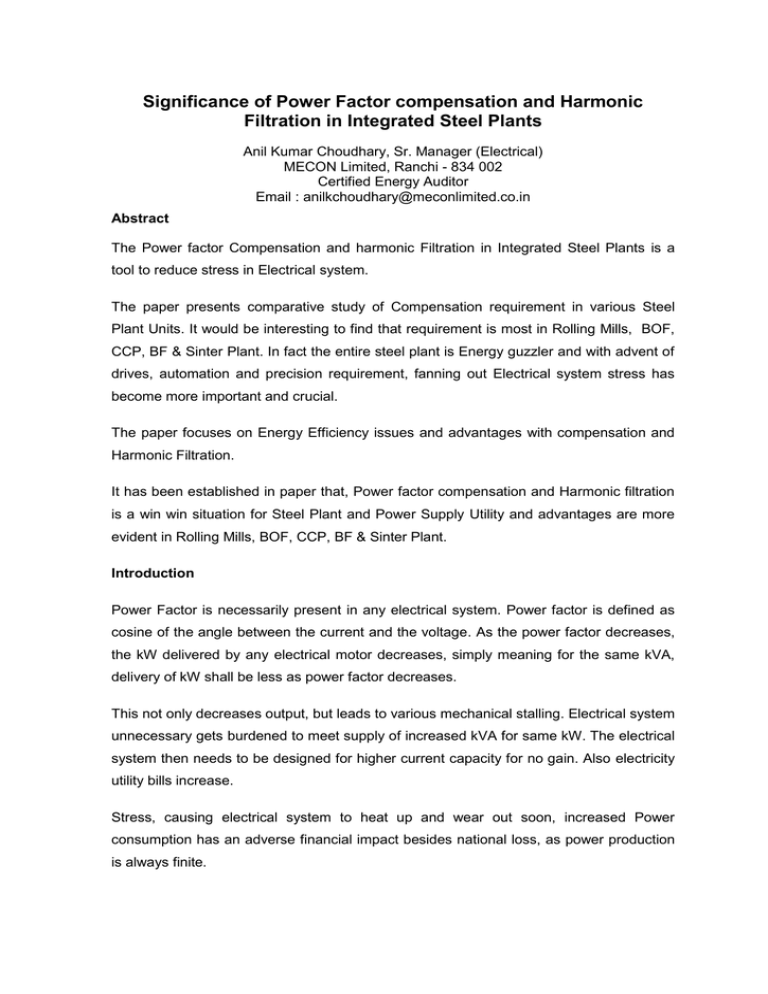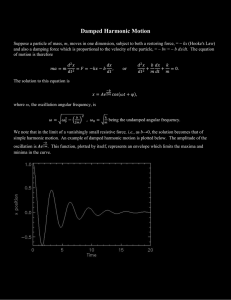Significance of Power Factor compensation and
advertisement

Significance of Power Factor compensation and Harmonic Filtration in Integrated Steel Plants Anil Kumar Choudhary, Sr. Manager (Electrical) MECON Limited, Ranchi - 834 002 Certified Energy Auditor Email : anilkchoudhary@meconlimited.co.in Abstract The Power factor Compensation and harmonic Filtration in Integrated Steel Plants is a tool to reduce stress in Electrical system. The paper presents comparative study of Compensation requirement in various Steel Plant Units. It would be interesting to find that requirement is most in Rolling Mills, BOF, CCP, BF & Sinter Plant. In fact the entire steel plant is Energy guzzler and with advent of drives, automation and precision requirement, fanning out Electrical system stress has become more important and crucial. The paper focuses on Energy Efficiency issues and advantages with compensation and Harmonic Filtration. It has been established in paper that, Power factor compensation and Harmonic filtration is a win win situation for Steel Plant and Power Supply Utility and advantages are more evident in Rolling Mills, BOF, CCP, BF & Sinter Plant. Introduction Power Factor is necessarily present in any electrical system. Power factor is defined as cosine of the angle between the current and the voltage. As the power factor decreases, the kW delivered by any electrical motor decreases, simply meaning for the same kVA, delivery of kW shall be less as power factor decreases. This not only decreases output, but leads to various mechanical stalling. Electrical system unnecessary gets burdened to meet supply of increased kVA for same kW. The electrical system then needs to be designed for higher current capacity for no gain. Also electricity utility bills increase. Stress, causing electrical system to heat up and wear out soon, increased Power consumption has an adverse financial impact besides national loss, as power production is always finite. To annihilate the same, capacitors are used preferably at load end to correct the power factor and keep it as close as unity. Even electrical utilities reward the plants with better power factor and impose penalty when power factor reduces beyond certain prescribed value. In Rolling Mills of all sectors, whether primary or secondary steel, the power factor correction requirement and its benefits become more grossly visible because of large quantum of power being consumed. Besides power factor, presence of harmonics plays a vital role in degrading the electrical system hence negatively affecting the plant performance. Harmonics are concern in the management of electrical system. Designers are required to pay more attention to quality power, energy efficient and reliable system. Because of variety of load requirement, especially in Mills, with multiple periodic/ non periodic impacts, the electrical system has to employ advanced electronics devices. These electronics devices, though capable of precise process control and energy savings benefits, brings in a drawback in terms of disturbance in Electrical system, called Harmonics. Designer’s concern in power factor correction and harmonic filtration in integrated steel plants The amount of Power handled in Steel Plants is enormous. Because of bulk load handling along non linear loads, the concern becomes more as the stress increases.. Following is the tabulation depicting the Maximum Demand of various units of an Integrated Steel Plant Power Distribution System: Bus voltage of SWBD Max. demand (MVA) P.F. 11 kV 24 0.85 6.6 kV 3 0.85 Flux crushing & screening 6.6 kV 6 0.85 Ore handling plant 6.6 kV 10.5 0.85 Coal handling plant 6.6 kV 9.3 0.85 Coke oven battery & by product plant, CDCP, coke sorting plant 11 kV 1.5 0.85 6.6 kV 11 0.85 Blast furnace 11 kV 31 0.8 6.6 kV 10 0.8 Raw material plant (Lime calcinations & dolo plant) 11 kV 13 0.85 Basic oxygen furnace 11 kV 44 0.85 6.6KV 3.5 0.85 Area of load centre Sinter plant Bus voltage of SWBD Max. demand (MVA) P.F. 11 kV 40 0.85 6.6KV 6 0.85 Bar & rod mill 11 kV 68.4 0.8 BRM - water treatment plant 6.6 kV 18.5 0.8 URM - water treatment plant 6.6 kV 6.4 0.8 Universal rail mill 11 kV 57.6 0.8 Intake & make-up water pump house 6.6 KV 3 0.8 Make-up water pump house 6.6 KV 6 0.8 Area of load centre Continuous casting plant Above load data is based on 3.0 Mt capacity integrated steel plant. The other steel plant data may differ depending on capacity and respective unit sizes and end products. It is now evident from above table that sinter plant, blast furnace, basic oxygen plant, continuous casting plant and mills are the prime energy guzzlers. Since non linear loads are more evident in blast furnace and mills, harmonics also plays major role. The incentive to improve power factor to unity is very much evident now. Due to quantum of power handled with most precise electronics system in automation and control, harmonic distortions become very much evident. Arresting the same and maintaining system reliability is an imperative requirement. Capacitor banks are installed for each Bus System. The capacity of capacitor banks (kVAr) are derived as follows: kVAr = kW (tan Ø1- tan Ø2) Where Ø1, Ø2 are the inverse cosine of existing and desired power factors respectively. kW is the power in killo Watts for existing power factor (Cos Ø1). To achieve power factor of 0.98 in various major units, following compensation is arrived at: MVA MW without compensation Compensation (MVAr) New MW Sinter plant 24 19.2 9.5 23.52 Blast furnace 41 32.8 17 40.17 BOF 47.5 38 19.3 46.51 BRM 68.4 54.72 34.4 67.02 URM 57.6 46.08 25.5 56.44 Units Hence for same MVA, there is much gain in MW availability after power factor correction to 0.98. It can be summarily noted that after one time installation of capacitor banks of 105.7 MVAr, there is increased availability of 43 MW (Demand equivalent to demand of BOF or mill, or even more than blast furnace). Harmonics : Origin, Effects and Consequences Harmonics currents are caused by non linear loads connected to the distribution system. A load is said to be non linear when current it draws does not have same wave shape as the supply voltage. The flow of harmonic current through the system impedances causes voltage distortion in the distribution system. Following are the major Harmonic generators. Industrial Processes viz, Welding, Impact Loads, Induction Furnaces, Battery Charger, DC Power Supplies Variable speed Drives for AC & DC motors Uninterrupted power Supplies Office Equipment (PCs, Printers, Servers, displays etc.) Harmonic currents increase the rms current in electrical systems and deteriorate the supply voltage quality. They cause stress in electrical network and potentially damage the equipment. They may disrupt normal operation of devices and increase operating costs. Symptoms of problematic harmonic levels include overheating of transformers, motors and cables, thermal tripping of protective devices and logic faults of digital devices. In addition, the life span of many devices is reduced by elevated operating temperatures. Mitigation of Harmonics In the state of the art ever evolving electrical technology, active front end is used in all the drives being used in mills, cranes and welding process. These electronic power quality devices are designed to measure the load current, calculate variance from objectives set in the mill and inject the right amount of current to meet the required level of harmonics, displacement power factor or load balancing. When harmonic mitigation is required, the logic measures the load current and calculates the harmonic current spectrum, i.e the amplitude and phase angle for every harmonic to as high as 50th order. The control signal is generated and semiconductors (IGBT) are directed to duplicate the control signal as injected into the supply. This reduces the supply side Harmonics. The typical control circuit is as given below. The achieved mitigation in one of the welding units in Rolling Mills is also depicted in the diagram. In the unit, electric filters are installed to comply following relevant standards and Norms: IEEE 519 : Recommended practices and requirements for harmonic control in Electrical Power Systems IEC 61000 : Assessment of emission limits for the connection of distorting installations to MV, HV and EHV power systems. ER G5 / ER G4 : Planning levels for harmonic voltage distortion and the connection of nonlinear equipment to transmission systems and distribution networks Conclusion Conventional measurement of the power factor is relevant only for loads that are linear and wave forms are purely sinusoidal. With increase in non linear loads of heavy capacity in precise automation requirement in rolling mills, harmonics play major role. When non linear loads exceed 50 % of the total load, as in case of blast furnace, rolling mills and welding lines, power factor correction cannot be achieved by capacitors alone. Capacitors can be destroyed due to overheating or resonance. Hence active harmonic filters are sized to keep total harmonic distortion under the prescribed limit. While designing plant and sizing electrical devices with active filters, the end value of compensation and harmonic filtration achieved should necessarily be calculated.




